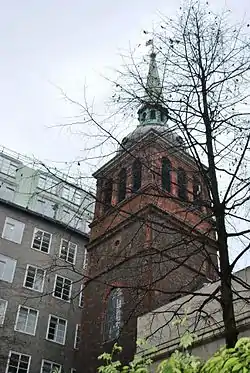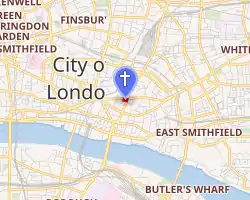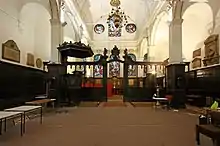St Peter upon Cornhill
St Peter upon Cornhill is an Anglican church on the corner of Cornhill and Gracechurch Street in the City of London of medieval, or possibly Roman origin. It was destroyed in the Great Fire of London in 1666 and rebuilt to the designs of Sir Christopher Wren. It is now a satellite church in the parish of St Helen's Bishopsgate. It lies in the ward of Cornhill.
| St Peter upon Cornhill | |
|---|---|
 | |
 | |
| Location | London, EC3 |
| Country | England |
| Denomination | Church of England |
| Previous denomination | Roman Catholicism |
| Architecture | |
| Heritage designation | Grade I listed building |
| Architect(s) | Christopher Wren |
| Style | Baroque |
| Years built | 1667 |
| Administration | |
| Parish | St Helen's Bishopsgate |
| Diocese | London |
Early history
Roman Location
The church of St Peter upon Cornhill stands on the highest point of the City of London, above the site of the old London roman Basilica (built c. AD90-AD120), with the eastern end and high altar being directly above the position where some basilicas of the period had a pagan shrine room. Immediately to the east of St Peter's, excavations under Gracechurch Street unearthed an adjoining room covered in yellow panels with a black border, 'with a tessellated floor, suggesting it may have had a higher status than normal, possibly acting as an antechamber for the aedes or shrine-room'. The alignment of the church is close to the lines of the basilica, being off by just two degrees and it is feasible for the understructure to have utilized the dry solid 2nd Century basilica wall fabric for support.[1]
A tradition grew up that the church was founded by Lucius, the first Christian King in Britain sometime after his conversion in AD179. He dedicated it to St Peter the Apostle and the church became the seat of an archbishop until the coming of the Saxons in the 5th century, after which London was abandoned and Canterbury became the seat for the 6th-century Gregorian mission to the Kingdom of Kent.[2]
The roman basilica, with most of the forum to the south, is thought to have been largely demolished around 300 AD,[3] with building material being removed (possibly for other projects) and the land levelled and eventually covered with a thick layer of dark soil. Whether St Peter's was in existence at this point, and continued to serve as a place of worship, or whether the Lucius story is a fable and the first St Peter's was only established many centuries later may only be determined by future archaeological investigation under the present church.
Two other facts however, may give credence to a Roman past. The first is that it is known that London sent a bishop, Restitutus, to the Council of Arles in 314 AD. Restitutus must have had a church base. Secondly, in 1417, the Mayor of London determined (during a dispute) that St Peter's was the first church founded in London.[4] Given that three other medieval churches also sat on the site of the Roman basilica, this suggests there may have been something in St Peter's location and longevity that justified it predating the others. Furthermore, given that St Paul's Cathedral was founded in 604, this clearly implies that Londoners in 1417 considered St Peters to have been founded pre-600.[5]
King Lucius Plaque
The London historian John Stow, writing at the end of the 16th century, reported "there remaineth in this church a table whereon is written, I know not by what authority, but of a late hand, that King Lucius founded the same church to be an archbishop's see metropolitan,[6] and chief church of his kingdom, and that it so endured for four hundred years".[7] The "table" (tablet) seen by Stow was destroyed when the medieval church was burnt in the Great Fire of London,[8] but before this time a number of writers had recorded what it said. The text of the original tablet as printed by John Weever in 1631 began:
Be hit known to al men, that the yeerys of our Lord God an clxxix [AD 179]. Lucius the fyrst christen kyng of this lond, then callyd Brytayne, fowndyd the fyrst chyrch in London, that is to sey, the Chyrch of Sent Peter apon Cornhyl, and he fowndyd ther an Archbishoppys See, and made that Chirch the Metropolitant, and cheef Chirch of this kingdom...[9]
A replacement, in the form of an inscribed brass plate, was set up after the Great Fire[8] and still hangs in the church vestry. The text of the brass plate has been printed several times, for example by George Godwin in 1839,[10] and an engraving of it was included in Robert Wilkinson's Londina Illustrata (1819–25).[11]
Medieval Church
Regardless of the Lucius connection, St Peter's is clearly one of the earliest churches in London. The date of the medieval church is uncertain but the first definitive reference was around 1038, when Ælfric II, bishop of Elmham, left a messauge (a dwelling with adjacent buildings and land) in his will to "St. Peter binnon Lunden" (St Peter in London).[12] In 1156 it is mentioned in a charter of Henry II. A list of vicars in the church records the first known appointment as one John de Cabanicig in 1263, with the patronage being claimed by Pope Urban IV for 'long voidance'.[13] In 1444 a "horsemill" was given to St Peter's. The bells of St Peter are mentioned in 1552, when a bell foundry in Aldgate was asked to cast a new bell.
Medieval Scriptorium
The church possessed a fine and ancient library and scriptorium, in use up to circa 1548. Sir John Crosby (died 1475) left money for the repairing of the library in his will.[14] It also contained a manuscript copy of the St. Jerome Vulgate that was written there in 1290. This scriptorium became a grammar school, certainly by 1425. However, this adjoining library 'is no longer extant and its exact location is not certain'.[15]
Present building


The medieval church was badly damaged in the Great Fire of London in 1666. The parish tried to patch it up, but between 1677 and 1684 it was rebuilt to a design by Christopher Wren at a cost of £5,647. The new church was 10 feet (3.0 m) shorter than its predecessor, the eastern end of the site having been given up to widen Gracechurch Street.[16]
St Peter's was described by Ian Nairn as having "three personalities inextricably sewn into the City".[17] The eastern frontage to Gracechurch Street is a grand stone-faced composition, with five arched windows between Ionic pilasters above a high stylobate. The pilasters support an entablature; above that is a blank attic storey, then a gable with one arched window flanked by two round ones. The north and south sides are stuccoed and much simpler in style. Unusually, shallow 19th-century shops have survived towards Cornhill, squeezed between the church and the pavement. The tower is of brick, its leaded cupola topped with a small spire, which is in turn surmounted by a weather vane in the shape of St Peter's key.[10][18]
The interior is aisled, with square arcade piers[19] resting on the medieval pier foundations. The nave is barrel vaulted, while the aisles have transverse barrel vaults.[18] Unusually for a Wren church, there is a screen marking the division between nave and chancel. This was installed at the insistence of the rector at the time of rebuilding, William Beveridge.[20]
St Peter's was formerly the regimental church of the Royal Tank Regiment, having been adopted as such in 1954 at the suggestion of the then rector, Douglas Owen, who had served as a Padre with the regiment. Since 2007 the regimental church has been St Mary Aldermary.[21]
The church was designated a Grade I listed building on 4 January 1950.[22] It is now a satellite church in the parish of St Helen's Bishopsgate and is used for staff training, bible studies and a youth club. The St Helen's church office controls access to St Peter's.[23]
Charles Dickens mentions the churchyard in Our Mutual Friend. A theatre group called The Players of St Peter were formed at the church in 1946 and performed there until 1987.[24] They are now based at St Clement Eastcheap where its members perform medieval mystery plays each November.
Features and points of interest

Music
In June 1834 14-year-old Elizabeth Mounsey became the organist of St Peter's. She remained in the position for 48 years, until her resignation in 1882.[25] The organ in the gallery of St Peter's has an autographed souvenir quote from a J.S. Bach Passacaglia on display, which Felix Mendelssohn gave to Mounsey on 30 September 1840 after he gave an impromptu performance on the church's organ.[26]
Jowett
In the 1830s, the notable missionary William Jowett was a lecturer at the church.[27]
Burials
 Churchyard seats
Churchyard seats Small garden
Small garden From corner of Cornhill and Gracechurch Street
From corner of Cornhill and Gracechurch Street
Notes
- King Lucius of Britain, David Knight, 2008 p98.
- Thomas Allen, Thomas Wright The History and Antiquities of London, Westminster, Southwark and Parts Adjacent Vol 3,1839, publisher George Virtue,London,pp 447–450
- The King Lucius tabula in St Peter Upon Cornhill church, London, John Clark, revised 1 April 2014, page 14, accessed 17 January 2022
- The King Lucius Tabula, John Clark (2014), p7, accessed 17 January 2022
- David Knight, 2008, p 83
- "The City of London Churches: monuments of another age" Quantrill, E; Quantrill, M p88: London; Quartet; 1975
- Stow, John (1842). A Survey of London, Written in the Year 1598. London: Whittaker & Co. p. 73.
- Newcourt, Richard (1708). Repertorium Ecclesiasticum Parochiale Londinense: An Ecclesiastical Parochial History of the Diocese of London. Vol. I. London: C. Bateman. p. 522.
- Weever, John (1631). Ancient Funerall Monuments. London. p. 413.
- Godwin, George; John Britton (1839). The Churches of London: A History and Description of the Ecclesiastical Edifices of the Metropolis. London: C. Tilt.
- Wilkinson, Robert (1819–25). Londina Illustrata. London: Robert Wilkinson. An illustration of Wilkinson's engraving is accessible at "Tufts Digital Library". Tufts University. Digital Collections and Archives: MS004.002.056.DO01.00049. hdl:10427/54651.
{{cite journal}}: Cite journal requires|journal=(help) - See The Electronic Sawyer, Online catalogue of Anglo-Saxon charters, University of Cambridge, S1489, accessed 17 January 2022. See original text and translation on Anglo-Saxons.net, accessed 17 January 2022; and also Henry A Harben, 'Peltry (The) - Peter (St.) de Bradestrate, Broadstreet', in A Dictionary of London (London, 1918),British History Online accessed 16 January 2022.
- A Manuscript list of 'Rectors of Saint Peter Upon Cornhill', hanging in the church, viewed 7 February 2022. The authority cited for this entry is 'Royal Letters, Vol IV, p 413.
- The Tomb, the Palace and a Touch of Shakespeare: The Memory of Sir John Crosby, CHRISTIANSTEER, 2006, The Riccardian, p5, accessed 6 February 2022
- David Knight, King Lucius, 2008,p 101
- Jenkinson, Wilberforce (1917). London Churches Before the Great Fire. London: Society for the Promotion of Christian Knowledge. pp. 120–3.
- Nairn, Ian (1966). Nairn's London. Harmondsworth: Penguin Books. p. 27.
- Bradley, Simon and Pevsner, Nikolaus. London: The City Churches. New Haven, Yale, 1998. ISBN 0-300-09655-0 p.123
- Malcolm, James Peller (1807). Londinium Redivivium, or, an Ancient History and Modern Description of London. Vol. 4. London.
- Hatts, Leigh. London City Churches, 2003, p.84 ISBN 978-0-9545705-0-7
- "Regimental Church & Collect". Royal Tank Regiment. Archived from the original on 20 July 2017. Retrieved 16 August 2017.
- Historic England. "Details from listed building database (1192245)". National Heritage List for England. Retrieved 23 January 2009.
- "Archived copy". Archived from the original on 27 April 2007. Retrieved 28 April 2007.
{{cite web}}: CS1 maint: archived copy as title (link) - Players of St Peter cast lists Archived 23 December 2012 at archive.today
- The Englishwoman's Review of Social and Industrial Questions: 1882 (Reprint ed.). Routledge. 2016. p. 318. ISBN 9781315403526.
- Musical Times, 1 November 1905, page 719 - In addition to the Passacaglia, he played Bach's Prelude and Fugue in E minor, and his own Prelude and Fugue in C minor, Op. 37, No. 1 and another fugue in F minor.
- Goodwin, G., revised by H. C. G. Matthew, 'Jowett, William (1787–1855), missionary', in Oxford Dictionary of National Biography (Oxford University Press, 2004)
External links
| Wikimedia Commons has media related to St Peter upon Cornhill. |
- St Peter upon Cornhill from Friends of the City Churches
- Emporis.com
- UK Attraction
- Set of 60 photographs of St Peter upon Cornhill Church by Rex Harris
- 1815 Seat plan of St Peter upon Cornhill Church
- St Helen's Bishopsgate